
Lebeckia is a genus of plants in the family Fabaceae native to the fynbos of South Africa. Several members of Lebeckia were recently transferred to other genera. Members of Lebeckia are known to produce pyrrolizidine alkaloids, including ammodendrine, lebeckianine, and lupanine.

Lotononis is a genus of flowering plants in the family Fabaceae and the tribe Crotalarieae. Almost all of the species in the genus occur in southern Africa.
Leobordea mirabilis is a known species of legume in the family Fabaceae. It is exclusive to Namibia. Its natural habitat is rocky areas.
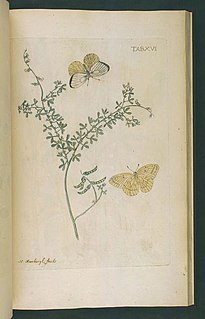
Melolobium is a genus of 15 species of flowering plants belonging to the family Fabaceae. It is native to southern Africa, where it is found in south and east Namibia, southwest Botswana, and most of South Africa.

Crotalarieae is a tribe of flowering plants belonging to the family Fabaceae. It includes rooibos (Aspalathus linearis), harvested for sale as a tisane.
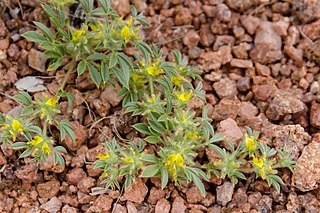
Leobordea platycarpa is a common annual plant in the drier parts of the African continent found in open ground, roadsides, cultivated ground and other disturbed places or in short grassland on sand.

Argyrolobium is a genus of flowering plants in the family Fabaceae. It belongs to the subfamily Faboideae. Members of this genus are found in Africa and south Asia.
Baphiopsis parviflora is an African species of flowering plants in the legume family, Fabaceae. It belongs to the subfamily Faboideae. It is the only member of the genus Baphiopsis. It was traditionally assigned to the tribe Swartzieae; however, recent molecular phylogenetic analyses reassigned Baphiopsis parviflora into the Baphieae tribe.
Grazielodendron riodocensis is a species of flowering plant in the legume family, Fabaceae. It belongs to the subfamily Faboideae, and was recently assigned to the informal monophyletic Pterocarpus clade within the Dalbergieae. It is the only member of the genus Grazielodendron. It is only found in Brazil.
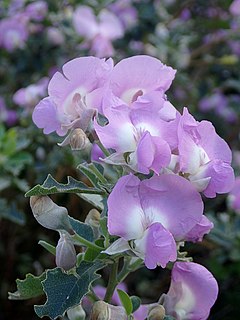
Podalyria is a genus of flowering plants in the family Fabaceae. It belongs to the subfamily Faboideae. The genus is endemic to South Africa.
Polhillia is a genus of flowering plants in the family Fabaceae. It belongs to the subfamily Faboideae.
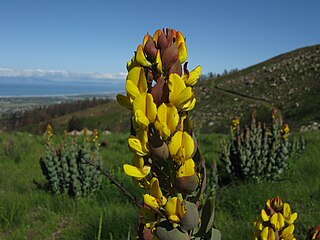
Rafnia is a genus of flowering plants in the family Fabaceae. It belongs to the subfamily Faboideae.
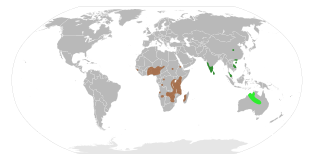
Rothia is a genus of flowering plants in the family Fabaceae. It belongs to the tribe Crotalarieae of subfamily Faboideae, and comprises two species:
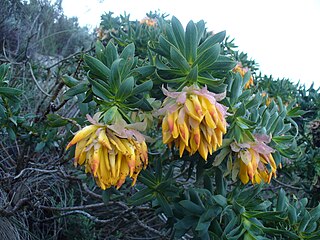
Liparia is a genus of flowering plants in the legume family, Fabaceae. It belongs to the subfamily Faboideae.

Xiphotheca is a genus of flowering plants in the legume family, Fabaceae. It belongs to the subfamily Faboideae. The name of the genus is a compound of Ancient Greek ξίφος (ksíphos), which means "sword", and θήκη (thēkē) which can mean "box" or "sheath"—a reference to the shape of the legume pods. Members of this genus can be distinguished by:
"(1) the presence of bracteoles in most species; (2) the fusion of the bracts with the base of the pedicel; (3) the laterally compressed pods; and (4) the accumulation of anabasine as a major alkaloid."
Ezoloba macrocarpa is a species of flowering plant in the family Fabaceae and the tribe Crotalarieae found in South Africa. It is the only species included in the genus Ezoloba.

Leobordea is a genus of legumes in the family Fabaceae and the tribe Crotalarieae. Members of this genus are found in the eastern parts of South Africa as well as tropical Africa and the Mediterranean countries. It was recently segregated from the genus Lotononis.
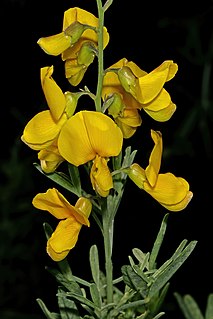
Calobota is a genus of flowering plants in the legume family, Fabaceae. It belongs to the subfamily Faboideae.
Wiborgiella is a genus of flowering plants in the family Fabaceae. It belongs to the subfamily Faboideae.












